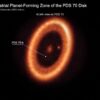Researchers led by Dr. Lu Kaixing from Yunnan Observatories of the Chinese Academy of Sciences have provided new insights into the broad-line region (BLR) of the active galactic nuclei (AGN), and achieved precise measurements of the supermassive black hole mass in AGN NGC 5548.
The study was published in The Astrophysical Journal Supplement Series on Nov. 9.
In 2015, the research team conducted a long-term spectroscopic monitoring project for a selected sample of widely known AGNs using the 2.4-m telescope of Lijiang observatory. They aimed to investigate the origin and evolution of BLRs, accurately measure the mass of supermassive black holes, and understand structure and evolution of the AGN.
NGC 5548 with double-peaked broad-line profiles underwent extreme variability in the past two decades, and as a candidate of sub-parsec SMBH binary candidate, was the highest-priority target of the long-term spectroscopic monitoring campaign.
Reverberation mapping (RM) is a method to directly detect the size and structures of radiation region for the distant AGN in time domain. “Our research demonstrates that reverberation mapping is a reliable and effective method to accurately measure the mass of supermassive black hole in AGN,” said Dr. Lu.
Currently, this research performed five-season observations for NGC 5548 and obtained five-season measurements of supermassive black hole mass for this AGN, with a dispersion of 13%, which is much better than previous dispersion of 41%.
Taking the five seasons of RM measurements into account, the seasons of RM measurements for NGC 5548 reach 23 in total, making it the most intensively RM-monitored AGN.
Combining the latest five-season results with historical data, the researchers found that the change of the BLR radius lags the varying optical luminosity with a timescale of 3.5 years, and the line dispersion (i.e., rotation velocity) of the BLR from 23 RM campaigns is not globally correlated with the optical luminosity.
“Both findings are not consistent with the normal ‘breathing effect’ of the BLR, that is the BLR radius (size) increasing and the line width decreasing with continuum luminosity,” said Dr. Lu.
The research team will continue to monitor NGC 5548 to better understand the structure and evolution of the BLR.
More information:
Kai-Xing Lu et al, Supermassive Black Hole and Broad-line Region in NGC 5548: Results from Five-season Reverberation Mapping, The Astrophysical Journal Supplement Series (2022). DOI: 10.3847/1538-4365/ac94d3
Provided by
Chinese Academy of Sciences
Citation:
Study provides new insights into broad-line region of active galactic nuclei (2022, November 14)



